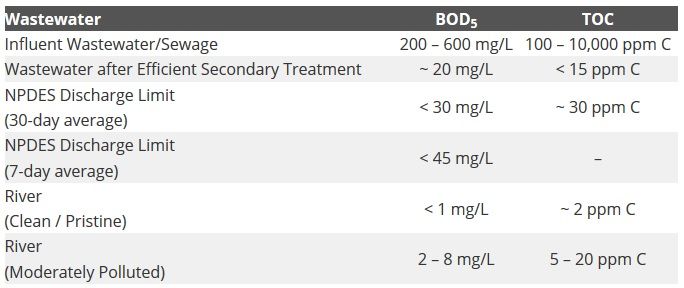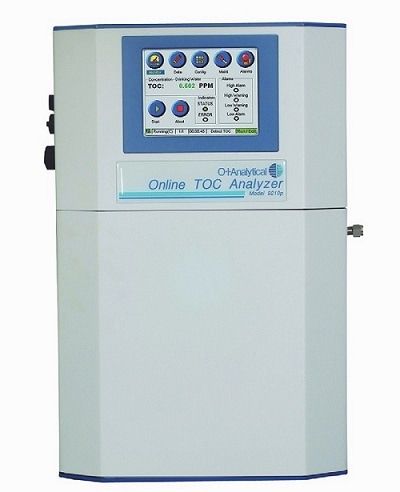Monitoring WTPs Using On-Line TOC Analysis
Published on by Marina A, Previously Key Account and Content Manager at AquaSPE AG in Monitoring
Unlike BOD tests that offer an indirect, empirical measurement of organic contamination, total organic carbon (TOC) analysis offers a direct quantitative estimation of organic contamination in wastewater and natural waters.
In order to determine the amount of oxygen used by the decomposition of organic matter during secondary wastewater treatment processes, wastewater treatment plants employ BOD5.
Up to 90% of the organic matter is consumed and eliminated by algae, bacteria, fungi, and other microorganisms during secondary wastewater treatment.
The test for BOD5 involves the measurement of oxygen consumed in mg/L during an incubation period of 5 days at a temperature of 20°C.
The standards and limits for secondary wastewater treatment parameters were laid down by the U.S. EPA after it evaluated the performance data of publicly owned treatment works (POTWs). The established limits/standards for BOD5 are 45 mg/L for an average period of 7 days, 30 mg/L for an average period of 30 days, and 85% BOD5 removal for an average period of 30 days.
Drawbacks of BOD Testing
The BOD5 test can be problematic and impractical in certain situations for the measurement of organic pollution loading. Due to its empirical nature, the accuracy of the BOD5 test is dubious.
This is emphasized by a note in U.S. EPA Method 405.1, which states “There is no acceptable procedure for determining the accuracy of the BOD test.”
One cause for the dubiousness of BOD test is high levels of algae concentrations in a sample. High algae concentrations can result in inaccuracy of BOD5 test results. The inability of algae cells to photosynthesize will lead to high consumption and depletion of oxygen in the dark BOD5 test conditions, which will lead to higher BOD5 values.
In certain cases, after five days of incubation, the dissolved oxygen level is zero. As there are no ways of discovering when the dissolved oxygen level reached zero, determining BOD becomes impossible.
Another drawback of BOD testing is the presence of certain chemicals in waste streams that prevent microbes’ growth and activity, resulting in lower BOD test results. Some of these chemicals include sanitizers and cleaning agents, antibodies, chlorine, and solvents.
Substitution of TOC Analysis for BOD Testing
Unlike BOD tests that offers an indirect, empirical measurement of organic contamination, total organic carbon (TOC) analysis offers a direct quantitative estimation of organic contamination in wastewater and natural waters. Due to this distinction TOC analysis is better suited for observing and controlling the wastewater treatment processes while the relative pollution of wastewater or water is revealed by BOD.
The U.S. EPA allows the use of TOC analysis to monitor oxygen-demanding substances in wastewater treatment plants. 40 CFR 133.104, paragraph (b) states; “Chemical oxygen demand (COD) or total organic carbon (TOC) may be substituted for BOD5 when a long-term BOD:COD or BOD:TOC correlation has been demonstrated.”
Organic pollutant loading can be evaluated at multiple points in a wastewater treatment plant through TOC analysis.


In order to substitute and report TOC values for BOD5 values, a wastewater treatment plant must perform a long-term correlation study. The results of the study must be submitted to the regulatory body that sanctioned the facility’s NPDES permit.
 As part of the long-term TOC:BOD correlation study, the climatic and seasonal effects on the efficiency of secondary treatment must be accounted for, by compiling data for a year or more. USEPA-approved methods that are used for NPDES permit compliance reporting must be used to collect the TOC and BOD5 test data.
As part of the long-term TOC:BOD correlation study, the climatic and seasonal effects on the efficiency of secondary treatment must be accounted for, by compiling data for a year or more. USEPA-approved methods that are used for NPDES permit compliance reporting must be used to collect the TOC and BOD5 test data.
The correlation study also includes data from the analysis of split samples of primary treatment effluents, primary treatment influents, plant influents, secondary treatment effluents, and final discharge effluents.
The heated persulfate oxidation technique is used by the OI Analytical 9210p On-line TOC Analyzer in the USEPA-approved Standard Method 5310C. This device can be used by wastewater treatment plants that perform correlation studies to substitute the BOD5 test values with TOC values for NPDES permit reporting.
A wastewater treatment plant must perform a long-term correlation study to substitute and report BOD5 values with TOC values. The results of the study must be submitted to the regulatory body, which sanctioned the facility’s NPDES permit. USEPA-approved methods that are used for NPDES permit compliance reporting must be used to collect the TOC and BOD5 test data.
A long term correlation study was conducted at the Dallas CWWTP for a period of four weeks to determine if TOC analysis can be a successful substitute for BOD test in monitoring wastewater treatment plants. The TOC results of the effluent and influent wastewater samples show that a wastewater treatment plant can successfully substitute BOD5 test values with TOC values by employing a 9210p On- line TOC analyzer.
Source: AZO Materials
Media
Taxonomy
- Industrial Wastewater Treatment
- Wastewater Treatment
- Water & Wastewater
- Water & Wastewater Treatment
- Water & Wastewater